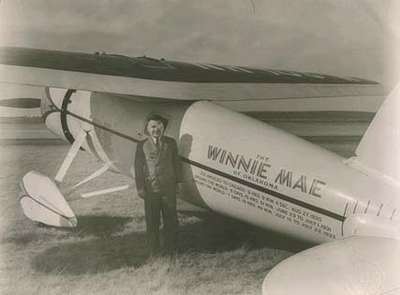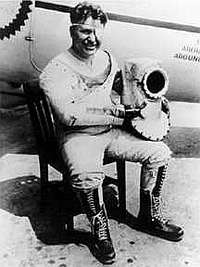Mon, Jul 21, 2003
Wiley Posts's Around-The-World Solo Flight
Millions of Americans were following closely on radio and in
special newspaper editions on July 21, 1933, as aviation history
was being made. Noted pilot Wiley Post was nearing the end of the
first solo flight around the world.

Harold Gatty had set the around-the-world record in 1931 at 8
days, 15 hours and 51 minutes. Two years later, Post, flying solo
in his Lockheed Vega, Winnie Mae, beat his earlier record
by 21 hours. Post fought Atlantic fog, Russian thunderstorms,
equipment problems and his own fatigue to set the incredible
record. Five years later, it took Howard Hughes flying a
twin-engined Lockheed with a crew of four to beat the one-eyed
pilot's record.
 Post took off from Floyd
Bennett Field, Long Island, on July 15, 1933. Aboard the Winnie
Mae were two new devices--a Sperry gyroscope and a radio
direction finder--that would make his flight without a navigator
that much easier. The gyroscope automatically corrected the plane
if it deviated from a particular bearing, while the radio direction
finder helped the pilot navigate toward certain distinct radio
transmitters. Although Post had problems with his gyroscope and he
suffered another bent propeller, he repaired both items and stuck
to his predicted pace. The result was a new around-the-world record
of 7 days 18 hours and 49 minutes. Post had bettered his previous
record by 21 hours.
Post took off from Floyd
Bennett Field, Long Island, on July 15, 1933. Aboard the Winnie
Mae were two new devices--a Sperry gyroscope and a radio
direction finder--that would make his flight without a navigator
that much easier. The gyroscope automatically corrected the plane
if it deviated from a particular bearing, while the radio direction
finder helped the pilot navigate toward certain distinct radio
transmitters. Although Post had problems with his gyroscope and he
suffered another bent propeller, he repaired both items and stuck
to his predicted pace. The result was a new around-the-world record
of 7 days 18 hours and 49 minutes. Post had bettered his previous
record by 21 hours.
The Winnie Mae is displayed in the National Air and
Space Museum.
Post was fascinated by high-altitude flight and reached an
unofficial altitude of 55,000 feet in 1934. His flights pioneered
the use of high-altitude flight suits, superchargers and
pressurized ignition systems for stratospheric flight. His plane
was fitted with two special superchargers to provide pressure to
his flight suit and to his engine.
Early in 1935, Post and fellow Oklahoman, Will Rogers, planned a
leisurely around-the-world flight. Post elected to fly a modified
Lockheed Orion, rather than his beloved Winnie Mae. Both
were killed departing Point Barrow (AK) when the engine quit
shortly after take-off.
More News
He Attempted To Restart The Engine Three Times. On The Third Restart Attempt, He Noticed That Flames Were Coming Out From The Right Wing Near The Fuel Cap Analysis: The pilot repor>[...]
Make Sure You NEVER Miss A New Story From Aero-News Network Do you ever feel like you never see posts from a certain person or page on Facebook or Instagram? Here’s how you c>[...]
From 2009 (YouTube Edition): Leading Air Show Performers Give Their Best Advice for Newcomers On December 6th through December 9th, the Paris Las Vegas Hotel hosted over 1,500 air >[...]
Aero Linx: NASA ASRS ASRS captures confidential reports, analyzes the resulting aviation safety data, and disseminates vital information to the aviation community. The ASRS is an i>[...]
“For our inaugural Pylon Racing Seminar in Roswell, we were thrilled to certify 60 pilots across our six closed-course pylon race classes. Not only did this year’s PRS >[...]
 NTSB Final Report: Rutan Long-EZ
NTSB Final Report: Rutan Long-EZ ANN FAQ: Turn On Post Notifications
ANN FAQ: Turn On Post Notifications Classic Aero-TV: ICAS Perspectives - Advice for New Air Show Performers
Classic Aero-TV: ICAS Perspectives - Advice for New Air Show Performers ANN's Daily Aero-Linx (06.28.25)
ANN's Daily Aero-Linx (06.28.25) Aero-News: Quote of the Day (06.28.25)
Aero-News: Quote of the Day (06.28.25)




